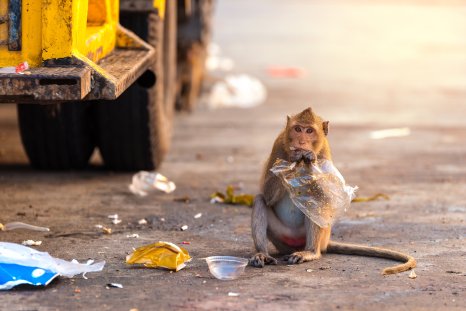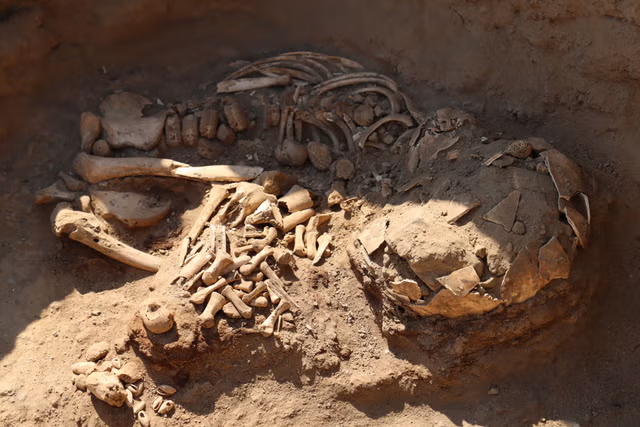Scientists may have a step forward in understanding how life on our planet came to exist.
The mystery of how tiny molecules of RNA came to be enclosed within membranes, forming the very first cells, may have been solved in a new paper in the journal Science Advances.
The researchers suggest that this ancient transition toward life may have involved rainwater.
"This is a distinctive and novel observation," Matthew Tirrell, a researcher at the University of Chicago Pritzker School of Molecular Engineering, said in a statement.
In the paper, the researchers describe how rainwater may have helped the earliest types of protocells form protective membranes around 3.8 billion years ago.
There are naturally occurring compartments of molecules called "coacervate droplets," which are thought to represent how the earliest cells on our planet formed. These coacervate droplets act similarly to drops of oil in water, containing molecules like proteins, lipids, and RNA within them.
"Membraneless coacervate microdroplets have long been proposed as model protocells as they can grow, divide, and concentrate RNA by natural partitioning," the researchers wrote in the paper.
The researchers describe how they investigated these droplets but found that they exchanged their interior molecules too easily to resemble the first cells.
Evolution relies on genetic differences between individuals. If early cells could exchange new RNA as quickly as these droplets could, then any new genes would spread throughout the whole population extremely quickly.
"If molecules continually exchange between droplets or between cells, then all the cells after a short while will look alike, and there will be no evolution because you are ending up with identical clones," UChicago postdoctoral researcher Aman Agrawal, a paper co-author, said in the statement.
It has long been theorized that the first genetic material on Earth wasn't DNA like our genes are made of, but RNA.
DNA contains the sugar deoxyribose, while RNA contains the sugar ribose, which has one more oxygen atom than deoxyribose, and DNA is typically double-stranded, forming a double helix structure. RNA is usually single-stranded and can fold into complex shapes and double-stranded regions.
"It's like a chicken-egg problem. What came first?" Agrawal said. "DNA is the molecule which encodes information, but it cannot do any function. Proteins are the molecules which perform functions, but they don't encode any heritable information."
"RNA is a molecule which, like DNA, can encode information, but it also folds like proteins so that it can perform functions such as catalysis as well," Agrawal said.
However, the discovery that coacervate droplets exchanged RNA too quickly stymied this theory somewhat.
"You can make all kinds of droplets of different types of coacervates, but they don't maintain their separate identity. They tend to exchange their RNA content too rapidly. That's been a long-standing problem," Jack Szostak, the director of UChicago's Chicago Center for the Origins of Life, said in the statement.
"What we showed in this new paper is that you can overcome at least part of that problem by transferring these coacervate droplets into distilled water – for example, rainwater or freshwater of any type – and they get a sort of tough skin around the droplets that restricts them from exchanging RNA content."
In the paper, the researchers suggested that pure rainwater could prevent these droplets from exchanging RNA quickly, increasing the time it took from minutes to days. According to the scientists, this would be enough time for mutations and evolution in these early cells.
"If you have protocell populations that are unstable, they will exchange their genetic material with each other and become clones. There is no possibility of Darwinian evolution," Agrawal said. "But if they stabilize against exchange so that they store their genetic information well enough, at least for several days so that the mutations can happen in their genetic sequences, then a population can evolve."
In experiments, the researchers used distilled water, suggesting that rain on ancient Earth would be chemically similar.
"This prompted the reviewers of the journal who then asked what would happen if the prebiotic rainwater was very acidic," Agrawal said. "We simply collected water from rain in Houston and tested the stability of our droplets in it, just to make sure what we are reporting is accurate,"
Interestingly, even with acidic rain, the same results were seen.
"The molecules we used to build these protocells are just models until more suitable molecules can be found as substitutes," Agrawal said. "While the chemistry would be a little bit different, the physics will remain the same."
Do you have a tip on a science story that Newsweek should be covering? Do you have a question about early cells? Let us know via science@newsweek.com.
References
Agrawal, A., Radakovic, A., Vonteddu, A., Syed, R., Huynh, V. N., Douglas, J. F., Tirrell, M. V., Karim, A., & Szostak, J. W. (2024). Did the exposure of coacervate droplets to rain make them the first stable protocells? Science Advances, 10(34). https://doi.org/10.1126/sciadv.adn9657
Disclaimer: The copyright of this article belongs to the original author. Reposting this article is solely for the purpose of information dissemination and does not constitute any investment advice. If there is any infringement, please contact us immediately. We will make corrections or deletions as necessary. Thank you.



